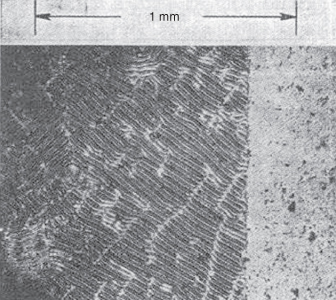13
The First Liquid Crystal Display
Nearly 80 years after Reinitzer’s discovery of naturally occurring liquid crystals in carrots, in 1962 Richard Williams found himself at the Radio Corporation of America Laboratories (“RCA Labs”), studying the synthetic negative anisotropy liquid crystal p-azoxyanisole (PAA), and wondering why the molecules tended to align with the applied electric field rather than having their perpendicular dipole moment turn them away, as theory predicted. While playing with the Lab’s Freedericksz cell, he noticed that turning the field on would produce an orderly black and white pattern as shown in Figure 13.1 at left, and turning the field off would result in a uniformly lighted pattern as shown at the right in the picture (electrode plates were used on the left half of the liquid crystal cell only, so the field-on and field-off domains could be compared side-by-side). Williams was perplexed, first with the anomaly of the reverse turn of the molecules, and then with the deeper question of just how does the electric field alter the light transmission through the liquid crystal when there is no net charge? [1]
Figure 13.1 Williams domain field-on striated pattern (left) and field-off uniform lighted pattern (right).
From Kawamoto, H. 2002. Proceedings of the IEEE, 90, 4, 465, April.

As for the first question, Williams surmised that within the PAA sample, there ...

